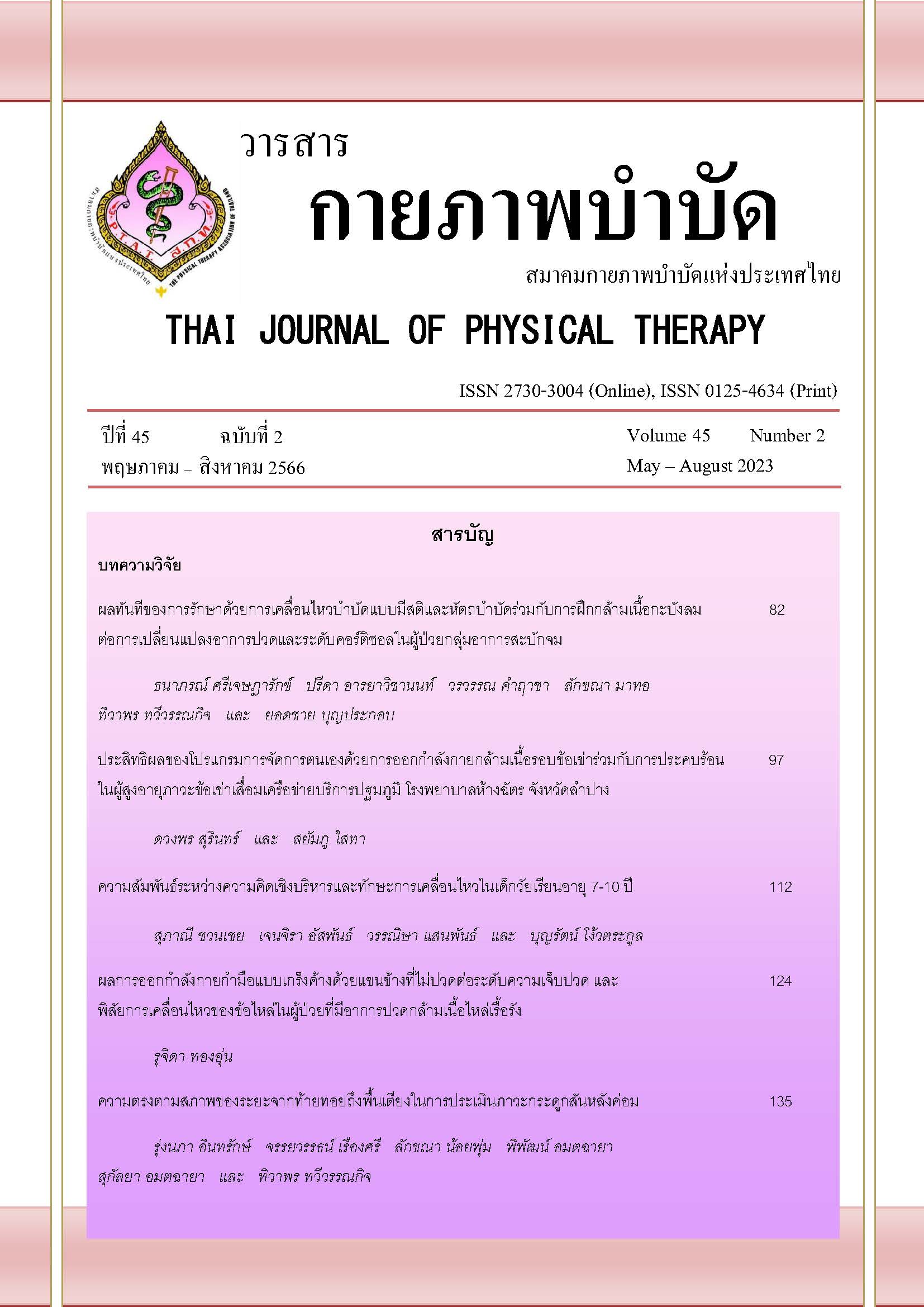ความตรงตามสภาพของระยะจากท้ายทอยถึงพื้นเตียงในการประเมินภาวะกระดูกสันหลังค่อม
Main Article Content
บทคัดย่อ
ที่มาและความสำคัญ: ภาวะกระดูกสันหลังค่อมเป็นปัญหาสุขภาพสำคัญที่อาจส่งผลกระทบเชิงลบต่อทั้งสุขภาพกายและจิตใจ ดังนั้น การประเมินเพื่อคัดกรองภาวะกระดูกสันหลังค่อมจึงมีความจำเป็นอย่างยิ่ง โดยการวัดระยะทางจากท้ายทอยถึงพื้นเตียงเป็นวิธีที่พัฒนาขึ้นใหม่ อย่างไรก็ตาม ยังไม่มีการรายงานค่าความตรงตามสภาพของเครื่องมือใหม่นี้เปรียบเทียบกับวิธีการวัดระยะทางจากท้ายทอยถึงผนังซึ่งเป็นวิธีที่นิยมใช้ในปัจจุบัน
วัตถุประสงค์: เพื่อศึกษาค่าความตรงตามสภาพของวิธีการวัดระยะจากท้ายทอยถึงพื้นเตียง โดยใช้การวัดระยะจากท้ายทอยถึงผนังเป็นวิธีมาตรฐาน
วิธีการวิจัย: การวิจัยนี้มีรูปแบบการศึกษาแบบภาคตัดขวาง โดยศึกษาในผู้ที่มีภาวะกระดูกสันหลังค่อมเมื่อประเมินโดยใช้ระยะจากท้ายทอยถึงผนังอย่างน้อย 6.5 เซนติเมตร อาสาสมัครมีอายุตั้งแต่ 10 ปีขึ้นไปทั้งเพศชายและเพศหญิงจำนวน 30 ราย จากนั้นอาสาสมัครได้รับการประเมินภาวะกระดูกสันหลังค่อมอีกครั้งโดยการวัดระยะจากท้ายทอยถึงพื้นเตียง ข้อมูลที่ได้จากการประเมินทั้งสองวิธีถูกนำมาวิเคราะห์ความตรงตามสภาพโดยรายงานค่าสัมประสิทธิ์สหสัมพันธ์
ผลการวิจัย: ค่าความตรงตามสภาพของวิธีการวัดระยะจากท้ายทอยถึงพื้นเตียงเทียบกับวิธีการวัดระยะจากท้ายทอยถึงผนังพบความสัมพันธ์ในระดับน้อย (rs = 0.432, p = 0.022) อย่างไรก็ตาม เมื่อวิเคราะห์ข้อมูลแบ่งตามช่วงอายุ พบความสัมพันธ์ในระดับดีเฉพาะช่วงอายุตั้งแต่ 60 ปีขึ้น (r = 0.779, p = 0.008)
สรุปผล: การประเมินภาวะกระดูกสันหลังค่อมโดยวัดระยะจากท้ายทอยถึงพื้นเตียงเหมาะสำหรับการนำไปคัดกรองในผู้สูงอายุ ซึ่งเป็นวิธีทางเลือกสำหรับบุคลากรทางการแพทย์ในการคัดกรองภาวะกระดูกสันหลังค่อมตั้งแต่แรกเริ่ม อย่างไรก็ตาม ควรมีการศึกษาเพิ่มเติมในอนาคตถึงค่าความตรงตามสภาพของเครื่องมือที่พัฒนาขึ้นใหม่เมื่อเปรียบเทียบกับวิธีมาตรฐานด้วยการถ่ายภาพรังสี
Article Details

อนุญาตภายใต้เงื่อนไข Creative Commons Attribution-NonCommercial-NoDerivatives 4.0 International License.
เอกสารอ้างอิง
Kado DM, Prenovost K, Crandall C. Narrative review: hyperkyphosis in older persons. Ann Intern Med. 2007; 147(5): 330-8.
Eslami S, Hemati J. Prevalence lordosis and dorsal kyphosis deformity among girls 23-11 years and its relationship to selected physical factors. Intl J Sport Std. 2013; 3(9): 924-9.
Cutler WB, Friedmann E, Genovese-Stone E. Prevalence of kyphosis in a healthy sample of pre- and postmenopausal women. Am J Phys Med Rehabil. 1993; 72(4): 219-25.
Roghani T, Zavieh MK, Manshadi FD, King N, Katzman W. Age-related hyperkyphosis: update of its potential causes and clinical impacts-narrative review. Aging Clin Exp Res. 2017; 29(4): 567-77.
Kado DM, Lui L-Y, Ensrud KE, Fink HA, Karlamangla AS, Cummings SR, et al. Hyperkyphosis predicts mortality independent of vertebral osteoporosis in older women. Ann Intern Med. 2009; 150(10): 681-7.
Katzman WB, Wanek L, Shepherd JA, Sellmeyer DE. Age-related hyperkyphosis: its causes, consequences, and management. J Orthop Sports Phys Ther. 2010; 40(6): 352-60.
Ailon T, Shaffrey CI, Lenke LG, Harrop JS, Smith JS. Progressive spinal kyphosis in the aging population. Neurosurgery. 2015; 77(4): S164-72.
Suwannarat P, Amatachaya P, Sooknuan T, Tochaeng P, Kramkrathok K, Thaweewannakij T, et al. Hyperkyphotic measures using distance from the wall: validity, reliability, and distance from the wall to indicate the risk for thoracic hyperkyphosis and vertebral fracture. Arch Osteoporos. 2018; 13(1): 25.
Wongsa S, Amatachaya P, Saengsuwan J, Thaweewannakij T, Amatachaya S. Validity of kyphosis measure using the occiput-wall distance and effectiveness of outcomes on the identification of impairments on functional endurance. Srinagarind Med J. 2013; 27(2): 125-32.
Briggs AM, Wrigley TV, Tully EA, Adams PE, Greig AM, Bennell KL. Radiographic measures of thoracic kyphosis in osteoporosis: Cobb and vertebral centroid angles. Skeletal Radiol. 2007; 36(8): 761-7.
Wongsa S, Amatachaya S. Kyphosis assessments. Arch AHS. 2014; 26(2): 105-16.
Di Bari M, Chiarlone M, Matteuzzi D, Zacchei S, Pozzi C, Bellia V, et al. Thoracic kyphosis and ventilatory dysfunction in unselected older persons: an epidemiological study in Dicomano, Italy. J Am Geriatr Soc. 2004; 52(6): 909-15.
Leidig-Bruckner G, Minne HW, Schlaich C, Wagner G, Scheidt-Nave C, Bruckner T, et al. Clinical grading of spinal osteoporosis: quality of life components and spinal deformity in women with chronic low back pain and women with vertebral osteoporosis. J Bone Miner Res. 1997; 12(4): 663-75.
Wiyanad A, Chokphukiao P, Suwannarat P, Thaweewannakij T, Wattanapan P, Gaogasigam C, et al. Is the occiput-wall distance valid and reliable to determine the presence of thoracic hyperkyphosis? Musculoskelet Sci Pract. 2018; 38: 63-8.
Antonelli-Incalzi R, Pedone C, Cesari M, Di Iorio A, Bandinelli S, Ferrucci L. Relationship between the occiput-wall distance and physical performance in the elderly: a cross sectional study. Aging Clin Exp Res. 2007; 19(3): 207-12.
Kado DM, Huang MH, Karlamangla AS, Barrett-Connor E, Greendale GA. Hyperkyphotic posture predicts mortality in older community-dwelling men and women: a prospective study. J Am Geriatr Soc. 2004; 52(10): 1662-7.
Tran TH, Wing D, Davis A, Bergstrom J, Schousboe JT, Nichols JF, et al. Correlations among four measures of thoracic kyphosis in older adults. Osteoporos Int. 2016; 27(3): 1255-9.
Huang MH, Barrett-Connor E, Greendale GA, Kado DM. Hyperkyphotic posture and risk of future osteoporotic fractures: the Rancho Bernardo study. J Bone Miner Res. 2006; 21(3): 419-23.
Chokphukiao P, Wiyanad A, Suwannarat P, Amatachaya S, Mato L, Wattanapan P, et al. Validity and reliability of the block method for measuring thoracic hyperkyphosis. Physiother Theory Pract. 2021: 1-8.
Portney LG, Watkins MP. Foundations of clinical research: Application to practice. 3rd ed. Upper Saddle River, NJ: Pearson – Prentice Hall, 2009.
Balzini L, Vannucchi L, Benvenuti F, Benucci M, Monni M, Cappozzo A, et al. Clinical characteristics of flexed posture in elderly women. J Am Geriatr Soc. 2003; 51(10): 1419-26.
Sinaki M, Khosla S, Limburg PJ, Rogers JW, Murtaugh PA. Muscle strength in osteoporotic versus normal women. Osteoporos Int. 1993; 3(1): 8-12.
Amatachaya P, Wongsa S, Sooknuan T, Thaweewannakij T, Laophosri M, Manimanakorn N, et al. Validity and reliability of a thoracic kyphotic assessment tool measuring distance of the seventh cervical vertebra from the wall. Hong Kong Physiother J. 2016; 35: 30-6.
Penha PJ, Joao SM, Casarotto RA, Amino CJ, Penteado DC. Postural assessment of girls between 7 and 10 years of age. Clinics (Sao Paulo). 2005; 60(1): 9-16.


